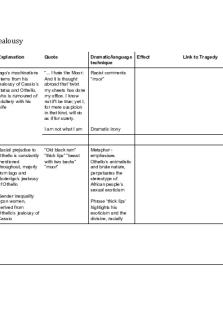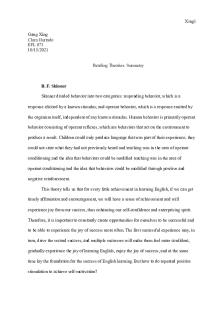Summary - Quotes, Essential Reading PDF

| Title | Summary - Quotes, Essential Reading |
|---|---|
| Course | Witchcraft, Magic and Power in Early Modern Europe |
| Institution | University of Birmingham |
| Pages | 4 |
| File Size | 139.7 KB |
| File Type | |
| Total Downloads | 2 |
| Total Views | 156 |
Summary
quotes...
Description
Oldridge: chapters 1, 2, 3 Witchcraft, magic and power in early modern Europe Seminar two
Example story of a woman using magic to escape persecution by being rescued by a demon ‘It would be misleading, however, to assume that the threat of witchcraft was a major preoccupation in medieval Europe.’1 – People usually accused of heresy rather than Satanism rather than practicing magic Modern phenomenon: sixteenth and seventeenth century ‘The concept of witchcraft that emerged in the late Middle Ages was a composite of several elements that existed separately until the 1430s. The blending of these elements was encouraged by intellectual and legal developments in the fifteenth century.’2 The threat of witchcraft used to raise standards of Christian behaviour in order to combat the devils power. ‘As the ultimate symbol of chaos, the Devil emerged as the natural leader of a secret plot to destroy Christendom.’3 ‘Henry Institoris, the principal author of the Malleus Maleficarum (1486), also emphasised Satan's power to bring about illness and misfortune through his surrogates in the witch cult. By focusing on demonic acts of maleficium, these men bridged the gap between learned demonology and peasant fears of harmful sorcery.’4 Changes in law; such as the introduction of inquisitorial procedures in courts, amd taking away the threat of punishing the accuser meant it was easier to bring forth prosecutions of witchcraft Confessions obtained with torture. ‘It is only with the benefit of hindsight that the sufferings of late medieval heretics may be viewed as part of a great European campaign to rid the world of witches.’5
1)Richard Kieckhefer: Witch trials in medieval Europe
‘The modern concept of witchcraft developed gradually in the course of the fourteenth and fifteenth centuries.’6 ‘It was not until… from around 1435 to 1500, that the ideas of nocturnal Devil-worship, the satanic pact and harmful magic were combined in a series of major trials, and even in this period such trials were still less common than prosecutions for simple sorcery.’7 ‘In comparison with the mass persecution of following centuries, the witch trials of the years 1300 – 1500 were few and sporadic.’ – occurred in separate towns. ‘Yet historians have rightly viewed the fourteenth and fifteenth centuries as witnessing the initial stages of the European witch craze. It was during this period that prosecution of witches first gained real momentum.’8
First period: 1300-1330 The rate of frequency was low; about one each year Mostly France, and England and Germany having witch hunts ‘Almost two thirds of them involved prominent ecclesiastical or secular figures’ either as suspects or sorceres victims. Trials of the Templars in France – an attempt of Phillip IV to confiscate their wealth
1 Pp. 20 2 Pp. 20 3 Pp. 20 4 Pp. 21 5 Pp. 21 6 Pp. 23 7 Pp. 23 8 Pp. 23
‘Though in some instances the accusers may have raised the charges cynically as ways of undermining their opponents, in the majority of cases the charges were no doubt based on sincere belief in the reality of witchcraft.’9 Luciferanism and diabolism crop up
Second period: 1330 – 1375
Still relatively tame accusations Luciferanism and diabolism still rather undeveloped and not many instances of trials
Third period: 1375 – 1435 ‘steady increase in the number of trials for witchcraft in general, and second an intensification of concern for diabolism.’10 Courts adopting a inquisitorial procedure – which did away with the earlier custom of judicial penalties for a accuser who failed to substantiate his charges. = more accusations? ‘a man accused a woman of weather magic, and when he was unable to prove his claim he himself was drowned. If those judicial rules had been maintained throughout Europe, no doubt very few people would have raised accusations of this kind, difficult as they were to prove’11 Plague: creating social friction as people migrated around Case study in Switzerland: where an accused sect were arrested and burned even though they caused harm to the authorities that tried to arrest them. Accused of diabolism and eating children. 1428: extensive persecution in Valais ‘the Devil seeks out men who are in a state of doubt or despair, and promises to make them rich, powerful, and successful, and to punish those who have done them harm.’12 Most concentrate on sorcery ‘A secondary result of this definition of witchcraft as heresy was that the stereotypes earlier found in heresy trials now increasingly transferred to witch trials.’13 New obsession with diabolism Final: 1435 to 1500 High rates of trials and persecutions ‘the intense witch-hunting of this stage anticipated, if it did not equal, the witch craze of the sixteenth and seventeenth centuries.’14 ‘The publication of Jacob Sprenger and Henry Institoris’ Malleus Maleficarum in 1487 made available a fully developed manual for witch hunters.’15 Most cases in France, Germany and Switzerland – mostly for sorcery alone, however diabolism was more frequently mentioned Became a huge problem in the later fifteenth century: vigilante justice etc. 2) Norman Cohn: The demonization of medieval heretics
‘The allegations of black magic, orgies and diabolism that were attached to heretical movements in the fourteenth and fifteenth centuries later resurfaced in the concept of a ‘witch cult’.’16 The poor lyons: excommunicated for preaching, when the Pope had denied them the right to do so, and condemned as heretics ‘Again and again, over a period of many centuries, heretical sects were accused of holding promiscuous and incestuous orgies in the dark; of killing infants and devouring their remains; of worshipping the Devil.’17 No evidence for the eating of children, and rarely any evidence given in courts
9 Pp. 24 10 Pp. 25 11 Pp. 26 12 Pp. 26 13 Pp. 28 14 Pp. 28 15Pp. 28 16 Pp. 31 17 Pp. 33
Discusses how such accusations, along with those of taking part in orgies, date back to the second century. ‘Embedded in theological works which were preserved in monastic libraries and which, moreover, were frequently recopied, these tales must have been familiar to many monks. It was only to be expected that, when it came to discrediting some new religious out-group, monks would draw on this traditional stock of defamatory clichés.’18 ‘In the Catharist view, souls are the angels who fell from heaven; they have been imprisoned in one body after another, and they yearn to escape from the material world and re-enter the heaven of pure spirituality.’ They fully reject the material world, which they link to demonic creation. Did the cult of the devil really exist? ‘The same people who accepted that a cult of Satan existed, also accepted that Satan miraculously materialized at the celebration of his cult, usually in the form of a gigantic animal. The two beliefs were practically inseparable, and if the one seems to lack evidential value, so should the other.’19 ‘There is in fact no serious evidence for the existence of such a sect of Devil-worshippers anywhere in medieval Europe. One can go further: there is serious evidence to the contrary’20 If there is little evidence for devil worshipping, why did people become suddenly so obsessed with the idea? ‘Many people, and particularly priests and monks, were becoming more and more obsessed by the overwhelming power of the Devil and his demons. That is why their idea of the absolutely evil an antihuman came to include devil-worships, alongside incest, infanticide and cannibalism.’21
3)Witchcraft and Reform in the Late Middle Ages Michael D. Bailey
“Notions of secret conventicles, perverse and often demonic orgies, infanticide, cannibalism, and other horrific elements quickly came together to form the full stereotype of the witches Sabbath.” 22 First heretics to be burned in the medieval West, at Orleans 1022: accused of participating in rites similar to those of later witches Sabbaths.23 Burning of children and using their ashes to make potions Origins in European folklore: transformation of witches in to animals. “Authorities simply uncovered these beliefs and practices among the peasantry and, misunderstanding them, twisted tem into witchcraft.”24 Sabbath: idea emerged slowly of people gathering in worship of the devil having sold their souls to him “Johann Nider, in his Formicarius, was the first clerical authority to argue explicitly that more women than men were inclined towards witchcraft… That he would fall back on standard arguments of feminine weakness when confronted with what was already emerging as a predominantly female evil is by no means surprising.”25 As the concept of witchcraft developed there was a shift from condemning sorcerers with impressive demonic powers to those who fell to the susceptibility to temptation and submission to demonic forces, with such abilities only obtained through this cost. Tales of witchcraft and the defences from bewitchment became exhortations to proper belief and pious living. Niders Formicarius: Accounts of saints and deeds performed by pious men and women presented a positive example, while negative stories of heresy and supersticion provided a example to avoid. The threat that maleficium could harm a good Christian at any time proved to be an all the more powerful stimulus to remain devoted to Christ and practices of the true faith as laid out by the clergy. Witches could only harm those who let their faith slip Thus, just as clerical authors had long been accustomed to employ tales of demonic power to demonstrate the consequences of weak faith and improper acts and to encouragc proper belief and behavior, so now they might use accounts of the horrors of witchcraft as a powerful tool in an essentially reformist effort to encourage a spiritual renewal among the laity.
18 Pp. 34 19 Pp. 35 20 Pp. 36 21 Pp. 36 22 Pp. 37 23 Pp. 38 24 Pp. 38 25 Pp. 39...
Similar Free PDFs

Triads - essential reading
- 13 Pages

Jealousy quotes summary othello
- 3 Pages

Quotes
- 6 Pages

Ryle reading summary
- 1 Pages

Reading Summary 2
- 1 Pages

Reading Summary 3
- 6 Pages

Reading Theories Summary
- 4 Pages

Reading Summary Lesson 1
- 1 Pages

Malcolm X Reading Summary
- 1 Pages

Reading Summary - Ch. 2
- 3 Pages

Seminar Reading Summary
- 8 Pages
Popular Institutions
- Tinajero National High School - Annex
- Politeknik Caltex Riau
- Yokohama City University
- SGT University
- University of Al-Qadisiyah
- Divine Word College of Vigan
- Techniek College Rotterdam
- Universidade de Santiago
- Universiti Teknologi MARA Cawangan Johor Kampus Pasir Gudang
- Poltekkes Kemenkes Yogyakarta
- Baguio City National High School
- Colegio san marcos
- preparatoria uno
- Centro de Bachillerato Tecnológico Industrial y de Servicios No. 107
- Dalian Maritime University
- Quang Trung Secondary School
- Colegio Tecnológico en Informática
- Corporación Regional de Educación Superior
- Grupo CEDVA
- Dar Al Uloom University
- Centro de Estudios Preuniversitarios de la Universidad Nacional de Ingeniería
- 上智大学
- Aakash International School, Nuna Majara
- San Felipe Neri Catholic School
- Kang Chiao International School - New Taipei City
- Misamis Occidental National High School
- Institución Educativa Escuela Normal Juan Ladrilleros
- Kolehiyo ng Pantukan
- Batanes State College
- Instituto Continental
- Sekolah Menengah Kejuruan Kesehatan Kaltara (Tarakan)
- Colegio de La Inmaculada Concepcion - Cebu




